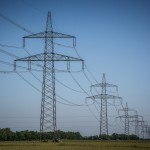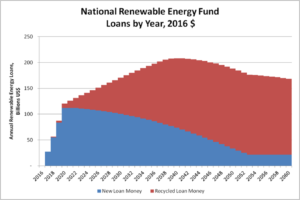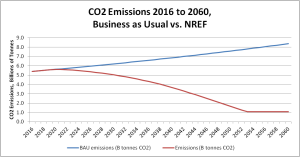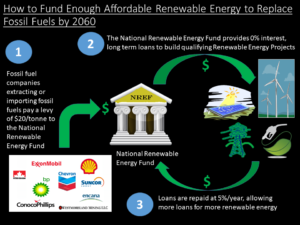What is the National Renewable Energy Fund and what is it for?
The National Renewable Energy Fund (NREF) is a proposed nationwide funding agency providing zero interest, long term loans to build renewable energy systems. It can provide the foundation for building enough low-cost renewable energy to remove the need for fossil fuels in our modern society.
How exactly would it work?
Fossil fuels (coal, oil and natural gas) are levied at $20/tonne of eventual CO2 emissions. This money is passed to the NREF where it used for loans to build low carbon renewable energy production and support systems. The money is repaid in equal installments over a 20-year period. Repaid money is loaned out to fund further projects.
Projects eligible for funding are diverse. The only requirements are they produce or support the production of renewable energy and they are able to pay the money back over 20 years. Potential projects include –

Renewable Power Production
- e.g. Land-based wind power; offshore wind power; floating wind power; utility scale PV solar power; commercial scale PV solar power; small scale PV solar power; thermal solar power; geothermal power; tidal power
Systems for supporting the utilization of renewable power

- e.g. Electric grid upgrades to connect renewable power; smart grid demand side management, pumped hydro energy storage; battery energy storage
Renewable Heat Energy
- e.g. Air exchange heat pumps; Geo-exchange heat pumps; High temperature heat pumps; Solar thermal collectors; Solar hot water
Renewable Hydrocarbon Energy

- e.g. Renewable natural gas production and collection; synthetic natural gas production from renewable energy; synthetic liquid fuel production from renewable energy; carbon capture for renewable fuel production; enhanced biofuel production
Why would using such a plan result in the cessation of fossil fuel use?
While on the surface this looks like any other carbon tax scheme, there is one critical difference.
The money collected isn’t given back to people, its not used for social programs or general government revenue. It is used for only one thing; building renewable energy systems to replace fossil fuel energy that caused the problem in the first place. This sets up a powerful negative feedback loop against fossil energy production. The more fossil fuel used, the more money is poured into systems to replace it. Modeling shows that using today’s technology and a $20/tonne levy, this can drive fossil fuel use to zero by 2060.
Would other policies be required?
Yes. Complementary renewable energy use mandates are required to ensure all this renewable energy being produced is used before fossil energy is used. While it is likely the renewable energy will cost less than fossil energy, there is no guarantee fossil fuel producers won’t drop their prices in a desperate bid to stay alive.
Also continued improvement in efficiency standards are a good idea as they lower the overall energy needed to be produced, but they are not mandatory.
Who would administer the fund?
Every country would likely have their own take on management of the fund. Key characteristics will be sound stewardship, transparency and lack of corruption. In Western democracies the Canada Pension Plan Investment Board (CPPIB) would likely be a good model to follow. It is a board of experts responsible to the government but separate from it. The board’s only focus would be reducing fossil CO2 emissions.
Why is this more effective than other carbon price plans?
Traditional carbon price plans are premised to work only by raising the price of fossil energy to the point that people reduce their use of it, either through curtailing their use (i.e. driving less, buying a more efficienct car), using alternatives (taking transit, riding a bike), or using renewable sources (biofuels). The carbon price only raises the cost of fossil energy, it does nothing to lower the cost of renewable energy.

The NREF raises the cost of fossil energy modestly while simultaneously lowering the cost of renewable energy dramatically. It does so in two ways. First, because renewable energy system are capital intensive, providing zero interest capital can cut the levelized cost of energy by half. In a typical renewable energy system today ½ of the overall cost is interest payments on debt. Second, is it provides a massive and consistent market for renewable energy and systems, on the order of $1T/year for 40 years.
Why 2060?
The year 2060 to have fossil fuel use go to zero was chosen based on a $20/tonne levy on fossil carbon. If we want to go faster, we need to raise the levy. For example $30/tonne would lead to zero fossil fuel in 2053, $40/tonne in 2049. However higher levies are more difficult politically.

